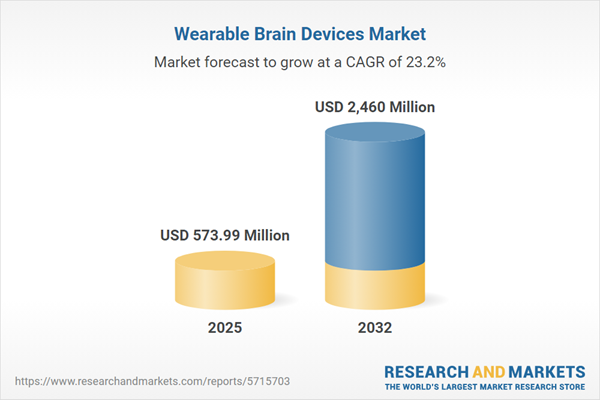Speak directly to the analyst to clarify any post sales queries you may have.
Wearable brain devices are transforming enterprise approaches to neurotechnology adoption, offering actionable insights and competitive advantages for organizations prioritizing digital transformation. Senior decision-makers require reliable intelligence on this dynamic market to align technology investments with evolving operational goals.
Market Snapshot: Wearable Brain Devices Market
The wearable brain devices market is experiencing accelerated global growth, driven by greater adoption across industries and ongoing innovation in brain-computer interface technology. Market revenues are projected to rise from USD 464.88 million in 2024 to USD 573.99 million by 2025, reflecting a compound annual growth rate of 23.18%. By 2032, the market is anticipated to reach USD 2.46 billion. Sector expansion is rooted in increased implementations within healthcare, wellness, and research settings, along with emphasis on cognitive health and integration with digital platforms. Providers are extending solution portfolios to enable access and application of these devices across multiple enterprise domains, responding to the uptick in neurotechnology adoption.
Scope & Segmentation of the Wearable Brain Devices Market
This research report delivers actionable market segmentation and insight for enterprise leaders exploring wearable brain devices and allied neurotechnology platforms. Segmentation supports informed decision-making, risk mitigation, and the alignment of partnership strategies in an evolving marketplace.
- Technology: Involves invasive brain implants, noninvasive EEG devices, deep brain stimulation platforms, functional near-infrared spectroscopy, and magnetoencephalography solutions, supporting a wide spectrum of diagnostic and operational requirements.
- Application: Addresses consumer and clinical environments, including gaming, physical training, meditation, sleep, diagnostics, rehabilitation, neurological assessment, and research, offering versatility in innovation and end-use value.
- End User: Spans digital wellness adopters, healthcare professionals, neurology clinics, rehabilitation centers, and research laboratories, each with unique needs for device deployment and integration within established workflows.
- Distribution Channel: Encompasses direct business purchase, collaboration with equipment manufacturers, specialist retail, and digital procurement, allowing buyers to tailor sourcing and implementation strategies to organizational requirements.
- Price Range: Reflects entry-level solutions designed for the public sector as well as premium, customizable products for enterprise integration at scale.
- Geographical Regions: Covers the Americas, Europe, Middle East, Africa, and Asia-Pacific, accommodating regional regulatory differences, infrastructure disparities, and unique compliance considerations for both global and localized operations.
- Company Coverage: Includes analytical profiles of NeuroSky Inc., EMOTIV Inc., InteraXon Inc., Advanced Brain Monitoring Inc., g.tec medical engineering GmbH, OpenBCI LLC, MindMaze SA, Cognionics Inc., Halo Neuroscience Inc., and NextMind SA, evaluating product offerings and partnership structures.
Key Takeaways for Senior Decision-Makers
- Emerging advancements in brain-computer interface sensors and artificial intelligence are shaping new models of workforce engagement and productivity, both in clinical and corporate environments.
- Strategic collaborations among technology vendors, healthcare service providers, and research organizations are streamlining neurotechnology integration, opening pathways for wider deployment and faster enterprise adoption.
- Implementing open architecture standards eases compliance requirements and facilitates simplified integration for organizations managing digital transformation or scaling platform deployment.
- Enterprises are prioritizing resilient supply chains to secure access to critical microelectronics, supporting consistent device availability and operational continuity as market and regulatory landscapes evolve.
- Leveraging the strengths of local regulatory frameworks and operational expertise allows companies to better meet global objectives while responding flexibly to changing market needs.
- Supplier approaches that reconcile the demands of specific end-users with wider institutional priorities position organizations for sustained adaptability as industry standards progress.
Analyzing Tariff Impact and Supply Chain Adjustments
Forthcoming US tariffs in 2025 are prompting enterprises to enhance supplier relationships and reevaluate sourcing methods for microelectronics. Flexible logistics and device design are being prioritized, ensuring continuity in operations and responsiveness to new regulatory demands.
Methodology & Data Sources
This report is informed by sector analyst expertise, hands-on practitioner feedback, patent analysis, scientific literature, and regular regulatory updates. Decision-makers receive evidence-based, actionable recommendations relevant to the wearable brain devices market.
Why This Report Matters
- Clarifies enterprise technology adoption methods and benchmarks supplier performance for efficient market entry and scaling.
- Enables proactive strategic planning with intelligence on segmentation and operating environments tailored to organizational realities.
- Guides supply chain and regulatory adaptation, enhancing enterprise resilience and supporting sustainable operational growth.
Conclusion
Wearable brain devices are emerging as a catalyst for enterprise innovation and operational flexibility. Clear strategy and targeted adoption enable organizations to adapt to shifting business environments and evolving technology landscapes.
Additional Product Information:
- Purchase of this report includes 1 year online access with quarterly updates.
- This report can be updated on request. Please contact our Customer Experience team using the Ask a Question widget on our website.
Table of Contents
3. Executive Summary
4. Market Overview
7. Cumulative Impact of Artificial Intelligence 2025
Companies Mentioned
The companies profiled in this Wearable Brain Devices market report include:- NeuroSky Inc.
- EMOTIV Inc.
- InteraXon Inc.
- Advanced Brain Monitoring Inc.
- g.tec medical engineering GmbH
- OpenBCI LLC
- MindMaze SA
- Cognionics Inc.
- Halo Neuroscience Inc.
- NextMind SA
Table Information
| Report Attribute | Details |
|---|---|
| No. of Pages | 193 |
| Published | October 2025 |
| Forecast Period | 2025 - 2032 |
| Estimated Market Value ( USD | $ 573.99 Million |
| Forecasted Market Value ( USD | $ 2460 Million |
| Compound Annual Growth Rate | 23.1% |
| Regions Covered | Global |
| No. of Companies Mentioned | 11 |









